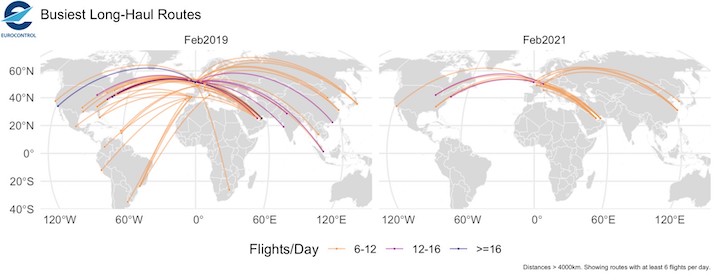
By February 2020, COVID-19 had already begun to affect the long-haul network out of Europe, in particular some routes to China. So we need to look back two years to see a 'normal' network over these distances. In February 2019, there were 61 high-frequency long-haul connections from Europe connections in the European network, if we take 'high-frequency' to mean 3 return flights per day (6 in total). The map clearly shows the world-wide reach of Europe's long-haul hubs. The large ones - London Heathrow, Frankfurt, Paris CDG and Amsterdam Schiphol - have high-frequency connections both east and west. But there are also smaller, more focused ones: Madrid and Lisbon with their connections to South America, Dublin just showing a connection to New York JFK here, Zurich, Milan and Rome. London and Paris also appear with connections from secondary airports, Gatwick and Orly.
With COVID-19, there are very few long-haul routes that can support even this frequency. Heathrow drops from 25 routes to just 7. Madrid, Lisbon, Dublin, Rome, Zurich have no routes over the threshold at all, although the strength of cargo means that Luxembourg is a new entry on the map. The secondary airports of London and Paris are no longer in the list. Two continents are now missing. Indeed, the frequent connections that remain are to just five countries: USA, UAE, Qatar, China and South Korea.
Even in normal times, frequency is to some degree a matter of business strategy: a double-daily connection may be enough. This may be why Hamad International airport in Doha, Qatar appears in both maps as often as Frankfurt, and why Istanbul does not appear at all.








